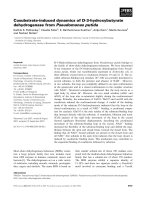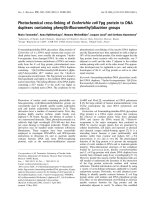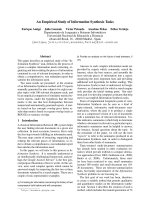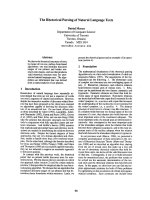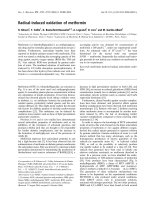Báo cáo khoa học: Cd2+-induced aggregation of Escherichia coli pyrophosphatase doc
Bạn đang xem bản rút gọn của tài liệu. Xem và tải ngay bản đầy đủ của tài liệu tại đây (165.27 KB, 4 trang )
Cd
2+
-induced aggregation of
Escherichia coli
pyrophosphatase
Yury V. Zimenkov
1
, Anu Salminen
2
, Irina S. Efimova
1
, Reijo Lahti
2
and Alexander A. Baykov
1
1
A. N. Belozersky Institute of Physico-Chemical Biology and School of Chemistry, Moscow State University, Moscow, Russia;
2
Department of Biochemistry, University of Turku, Finland
We report here that Escherichia coli pyrophosphatase
aggregates in the presence of m illimolar Cd
2+
. This highly
cooperative process was specific to both the metal ion and
the protein and could be reversed fully by decreasing the
Cd
2+
concentration. Aggregation was enhanced by Mg
2+
,
the n atural cofactor of pyr ophosphatase, and Mn
2+
.
Mutations at the intersubunit metal-binding site had no
effect, whereas mutation a t Glu139, which is p art of the
peripheral metal-binding site found in pyrophosphatase
crystals near the contact region between two enzyme m ole-
cules, suppressed aggregation. These findings indicate that
aggregation is affected by Cd
2+
binding to the peripheral
metal-binding site, probably by strengthening intermole-
cular Trp149–Trp149¢ stacking interactions.
Keywords: aggregation; cadmium; inorgan ic pyrophospha-
tase; site-directed mutagenesis.
Protein aggregation is a common phenomenon, with
important practical implications. A variety of diseases,
including the amyloidoses and prion diseases, as w ell as
other protein deposition disorders, involve protein aggre-
gation [1]. In most cases, the proteins that aggregate are
totally or partially unfolded, and the aggregation, which
occurs via hydrophobic interactions, is almost completely
irreversible [2,3]. Examples of proteins aggregating in their
native state, other than salting out and isoelectric point
precipitation, are l ess common, with the aggregation of t he
mutant hemoglobin t hat causes s ickle-cell anemia b eing
the best known example [4]. In addition, Zn
2+
and other
divalent cations have been reported to aggregate native
dodecameric g lutamine synthethase into tubular structures
[5] and to have a role in amyloid formation [6,7].
Escherichia coli inorganic pyrophosphatase (PPase) is an
essential enzyme that converts p yrophosphate, a byproduct
of many biosynthetic reactions, into phosphate [8]. The
native PPase molecule is formed by six identical subunits, of
20 kDa each, arranged in parallel layers of trimers [9,10].
Each subunit has an active site, resembling a large cavity,
with subsites for two phosphate molecules and four divalent
metal ions that can act as cofactors (Mg
2+
,Mn
2+
)or
inhibitors (Ca
2+
). In the absence of pyrophosphate or
phosphate, only two Mg
2+
ions are bound to the active site
[11]. In addition, one Mg
2+
ion is bound at the intertrimeric
interface, where it i s octahedrally associated with six water
molecules, which in turn hydrogen bond to the Asn24 and
Asp26 residues of the two interacting subunits [12,13].
PPase is a re adily soluble e nzyme that shows no tendency
to aggregate in a variety of conditions. We s how here,
however, that this enzyme reversibly aggregates in the
presence of C d
2+
, a common polluting ion that is toxic to
E. coli at millimolar concentrations [14], and we describe
the mechanism behind this aggregation.
Materials and methods
Wild-type E. coli PPase and PPase variants were prepared
and purified as described previously [15]. The final prepa-
rations were homogeneous, according to SDS/PAGE.
Enzyme aggregation was followed by measuring the
absorbance of enzyme solution at 440 nm in a quartz cuvette
of 1 cm path length. In kinetic experiments, an aliquot of
0.1
M
cadmium acetate solution was added to 0.7 mL of
enzyme solution (0.37 mgÆmL
)1
) containing 0.1
M
Tris/HCl
(pH 7.2), 1 m
M
MgCl
2
and 5 m
M
dithiothreitol; the contents
of the cuvette were rapidly mixed and the absorbance was
recorded on a Pharmacia-LKB Ultrospec Plus spectropho-
tometer. In titration experiments, metal salt was added in
1.4 lL increments, the contents of the cuvette were stirred
for 3 min, and the absorbance of the solution was measured.
This time was selected on the basis of the observation that
3 min was sufficient for aggregation to reach > 85% of its
equilibrium level under a v ariety of conditions. Each
titration was repeated at least three times, and the SD value
for the parameter describing the titration curve (c
½
)was
calculated. Except where stated otherwise, aggregation of
0.37 mgÆmL
)1
solutions of PPase was measured at 20 °C
in a buffer at 0.1
M
ionic s trength.
The initial rates of PP
i
hydrolysis were measured by a
continuous P
i
assay [16] in a reaction mixture containing
20 l
M
PP
i
,20m
M
MgCl
2
,0.15
M
Tris/HCl (pH 7.2), and
0.2 m
M
EGTA. The reaction was initiated by adding
enzyme (4–10 ngÆmL
)1
final concentration) and was carried
out for 3–4 min at 25 °C.
Correspondence to R. Lahti, Department of Biochemistry, University
of Turku, FIN-20014 Turku, Finland. Fax: + 358 2333 6860,
Tel.: + 358 2333 6845, E-mail: reijo.lahti@utu.fi; or A. A. Baykov,
A. N. Belozersky I nstitute of Physico-Chemical Biology a nd Schoo l of
Chemistry, Moscow State University, Moscow 119899, Russia.
Fax: + 7095 9393181, Tel.: + 7095 9395541,
E-mail:
Abbreviations: c
½
, values for the parameter describing the titration
curve; PPase, Escherichia coli inorganic pyrophosphatase.
Enzyme: inorganic pyrophosphatase (EC 3.6.1.1).
(Received 23 March 2004, revised 26 May 2004, accepted 1 June 2004)
Eur. J. Biochem. 271, 3064–3067 (2004) Ó FEBS 2004 doi:10.1111/j.1432-1033.2004.04239.x
Results and discussion
General characteristics of PPase aggregation
Upon addition of 2 m
M
Cd
2+
, we noted the development of
turbidity in the PPase solution, with a gradual increase in
absorbance at 440 n m owing to light scattering by aggregate
particles (Fig. 1). A fter sedimenting the aggregated protein
in an Eppendorf microcentrifuge, less than 10% of PPase, as
measured by activity and p rotein content, remained in the
supernatant. The aggregated PPase could be easily solubi-
lized, with a complete recovery of activity, by suspending the
sediment in buffer c ontaining no cadmium salt, indicating
that the native tertiary structure is regained when the Cd
2+
is removed.
The dependence of aggregation on Cd
2+
concentration
was characteristic of a highly cooperative process (Fig. 2).
Virtually no aggregation w as observed at c oncentrations of
<1 m
M
Cd
2+
,whereas,at 1.5 m
M
Cd
2+
, the ag gregation
was nearly complete. The theoretical curve, shown in Fig. 2,
was constructed assuming that the aggregation depends on
the 12th(!) power of Cd
2+
concentration.
The position of this curve along the abscissa depended on
reaction conditions and could be c haracterized by c
½
,the
Cd
2+
concentration corresponding to half the maximum
A
440
(Fig. 2). The value of c
½
was determined manually and
found to be 1.20 ± 0.06 m
M
under the standard conditions
(0.37 mgÆmL
)1
enzyme concentration, 0.1
M
ionic strength,
20 °C) used for the experiment described in Fig. 2.
Among the factors tested, ionic stren gth, which was
adjusted bythe a ddition ofKCl, had the greatest effect on c
½
.
When the ionic strength was increased to 0.16, 0.2 and 0.6
M
,
the c
½
increased to 2 .6 ± 0.1, 3.0 ± 0.2 and 1 1 ± 1 m
M
,
respectively, indicating that increased ionic s trength d e-
creased the tendency of the protein to aggregate. T his
observation suggested that the aggregation is governed by
ionic f orces, a finding supported b y the temperature
dependence of this process, in th at c
½
decreased from
1.20 ± 0.06 m
M
at 20 °C to 0.8 ± 0.1 m
M
at 2 °C. The
effect of PPase concentration on c
½
was m oderate, in that the
latter increased to 1.70 ± 0.09 m
M
at 0.08 mgÆmL
)1
PPase.
Specificity of the aggregation
Cd
2+
-induced aggregation was quite specific to E. coli
PPase. No aggregation of the homologous yeast pyrophos-
phatase was observed at Cd
2+
concentrations up to 11 m
M
[17,18], a finding confirmed by us (data not shown). Because
of its specificity, the aggregation could be used as a simple
and e fficient step in PPase purification. We found th at the
addition of 4.5 m
M
cadmium acetate to an E. coli extract
freed from nucleic acids [19] quantitatively precipitated
PPase; the higher cadmium acetate concentration was
required because of a low concentration of PPase in the
extract. This precipitated PPase could be subsequently
dissolved in Cd
2+
-free buffer. This aggregation step resulted
in a sixfold purification of PPase, with an increase of specific
activity from 26 to 150 IUÆmg
)1
, and a yield of 90%. Thus,
only small amounts of other proteins in the E. coli extracts
were co-precipitated with PPase.
PPase aggregation was also quite specific with respect to
the divalent metal ion used. Of the other metal i ons tested,
only C u
2+
and Z n
2+
induced aggregation, but their
effective concentrations were much higher than that of
Cd
2+
(Table 1). No aggregation was observed in the
presence of the PPase cofactors Mg
2+
and M n
2+
and
the PPase inh ibitor Ca
2+
, all of which bind to PPase. The
nature of th e anionic counterion (acetate or chloride) in the
metal salt had no effect on c
½
.
Identification of the metal-binding site
E. coli PPase possesses three types of metal-binding sites.
Type 1 sites, of which there are two per monomer in the
absence of su bstrate, are found in the active site cavity and
are not involved in intersubunit or intermolecular contacts
[12,13]. Type 2 sites, of which there are 0.5 per monomer,
are found in the intersubunit c ontact region; each of these
sites has ligands – Asn24 and Asp26 – from two subunits
Fig. 1. Time-course of Escherichia coli inorganic pyrophosphatase
(PPase) aggregation in the presence of 2 m
M
cadmium acetate.
Fig. 2. Dependence of Escherichia coli inorganic pyrophosphatase
(PPase) aggregation on cadmium acetate concentration. Absorbance
values were measured 3 min after each metal salt addition. The line
was obtained with the following equation: A
440
¼ 1.03/(1 + 9.34/
[Cd
2+
]
12
).
Ó FEBS 2004 Aggregation of pyrophosphatase (Eur. J. Biochem. 271) 3065
within the same hexamer [12,13]. Metal binding to type 2
sites strongly modulates trimer–trimer interactions in hexa-
meric PPase [22]. Type 3 sites, of which there are six per
hexamer, are found on the surface of the enzyme molecule
and are formed by the Glu139 side-chain and backbone
oxygens and the Val150 backbone oxygen [23] (Fig. 3).
We ruled out the involvement of type 1 and type 2 sites in
Cd
2+
-induced aggregation by testing the effects of Mg
2+
and Mn
2+
. Both of these divalent cations bind to type 1 and
2 sites, with dissociation constants ranging from 0.076 to
6.6 m
M
for Mg
2+
and from 0.006 to 0.35 m
M
for Mn
2+
[11]. Neither Mg
2+
nor Mn
2+
, however, binds to type 3
sites [12,13]. As neither Mg
2+
nor M n
2+
aggregated PPase
(Table 1), they would be expected to increase the c
½
for
Cd
2+
because of simple competition if the aggregating
Cd
2+
ion binds to type 1 or type 2 sites. We actually
observed t he opposite effect, in that c
½
,whichwas
2.6 ± 0.1 m
M
in the absence of Mg
2+
and Mn
2+
(0.16
M
ionic strength), decreased to 2.0 ± 0.1 m
M
in the presence
of either 20 m
M
Mg
2+
or 20 m
M
Mn
2+
. Our finding, that
Mg
2+
and Mn
2+
ions potentiated the effects of Cd
2+
,
indicates t hat aggregation is caused by Cd
2+
binding to sites
other than types 1 and 2.
The lack of competition between Cd
2+
and the other
metal ions in inducing aggregation suggested that aggrega-
tion is governed by type 3 sites. This finding was supported
by our results on PPase variants with specific mutations at
the metal-binding sites (Table 2). A mutation at the
peripheral type 3 site (E139Q) markedly increased c
½
(Table 2) and slowed down the aggregation (Fig. 1). By
contrast, mutations at the intersubunit site (N24D, D26N
and D26S) had no effect on c
½
or aggregation kinetics,
although they stimulated (N24D) or eliminated (D26N and
D26S) Mg
2+
binding to this site [22]. Based on these d ata,
we conclude that Cd
2+
binding to type 3 sites is responsible
for PPase aggregation.
Possible mechanism
One possible explanation of the Cd
2+
effect on PPase is t hat
the Cd
2+
binds to peripheral metal-binding sites from
different hexamers, i.e. Cd
2+
serves as a bridging atom.
Structural analysis predicts, however, that although t his
Cd
2+
ion is located on the protein surface, it may not be
available to bind another hexamer without inducing signi-
ficant structural alterations around the metal-binding site.
A more probable a lternative is that Cd
2+
binding to the
peripheral metal-binding site strengthens the intermolecular
Trp149–Trp149¢ stacking interaction observed in PPase
crystals [10]. Trp149 belongs to the most flexible segment
(residues 147–153) of the loop shown in Fig. 3, as indicated
by high B-factor values in s tructures that c ontain no bound
metal ion in the peripheral binding site [9,10,12,13]. This
segment also contains Val150, one of the metal ligands.
Therefore, a bound metal ion would act to fix the 147–153
Fig. 3. A stereo view of the hexamer–hexamer contact obse rved in Escherichia coli inorganic pyrophosphatase (PPase) crystals [23]. The bound Ca
2+
ion is shown as a b lack sphe re, and its c oordin ation b onds are s hown as d ash ed line s. Unprim ed and prime d am ino ac id residue num bers an d metal
ions refer to two different subunits from two n eighboring hexamers.
Table 2. The effects of residue substitutions on c
½
for E scherich ia coli
inorganic pyrophosphatase (PPase) aggregation by cadmium acetate.
The v alues for the parameter describing the titration curve (c
½
)were
measured as described in the legend of Fig. 2.
PPase variant c
½
(m
M
)
WT 1.20 ± 0.06
N24D 1.16 ± 0.06
D26N 1.17 ± 0.06
D26S 1.17 ± 0.06
E139Q 2.2 ± 0.1
Table 1. Comparison of different metal ions in their ability to aggregate
Escherichia c oli inorganic pyrophosphatase (PPase) and general chem-
ical parameters. The most commonly occurring coordination numbers
and respective ionic radii are separated by Ô/Õ. The preferred coordi-
nation numbers are shown in bold. The values for the parameter
describing the titration cu rve (c
½
) were measured as described in
Fig. 2.
Metal salt c
½
(m
M
)
Cation
coordination
number [20]
Cation
ionic
radius (A
˚
) [21]
CdCl
2
1.20 ± 0.06 4/5/6 0.78/0.87/0.95
ZnCl
2
6.5 ± 0.3 4/5/6 0.60/0.68/0.74
CuCl
2
13 ± 1 4/5/6 0.57/0.65/0.73
MgCl
2
> 100 6 0.72
CaCl
2
> 100 6/7/8 1.00/1.06/1.12
MnCl
2
> 100 4/5/6 0.66/0.75/0.83
3066 Y. V. Zimenkov et al. (Eur. J. Biochem. 271) Ó FEBS 2004
segment in space [23] and may adjust the position of Trp149
to allow its optimal interaction with its symmetrical partner
in the other hexamer. Furthermore, the dependence of the
aggregationon[Cd
2+
]
12
in the millimolar range (Fig. 2),
suggests that the corresponding Cd
2+
-binding constant is
well above 1 m
M
and that a ggregate formation or growth
requires that C d
2+
should be p resent in at least 1 2
peripheral sites in the interacting enzyme molecules. The
effect of ionic strength on aggregation may thus be mediated
by its effect on the Cd
2+
-binding constant. Further studies
are, however, needed to explain the unusually strong Cd
2+
concentration dependence in structural terms.
The above mechanism suggests that, in order to be
effective at aggregating PPase, Cd
2+
wouldhavetobindto
a type 3 binding site and properly position Trp149. These
requirements c learly impose limitations on the c ation
coordination number and ion ic radius. The preferred
coordination number for all of the aggregating cations is
four (Cd
2+
can equally well adopt six ligands), whereas the
non-aggregating c ations have a coordination number of six
or eight (Table 1). There is also a correlation between the
value of c
½
and the ionic radius within the group of the
aggregating cations. However, the high value of c
½
observed f or Cu
2+
, m ay also result from the fact that this
cation favors square planar coordination rather than the
tetrahedral coordination favored by Cd
2+
and Zn
2+
[20].
The i nability of Ca
2+
to aggregate PPase (Table 1), despite
its presence i n the crystal structure [23], suggests that Ca
2+
does not ensure proper orientation of T rp149. Indeed, even
in the crystal structure, where the neighboring protein
molecules contribute to such an orientation, the Trp149
side-chain planes are not parallel in Ca
2+
PPase (Fig. 3).
Acknowledgements
The authors thank A. N. Parfenyev and I. P. Fabrichniy for help. Th is
work was supported by grants from the Russian Foundation for Basic
Research (03-04-48798), the Ministry of Industry, Science and
Technologies of the Russian Federation (1706-2003-4), and t he Finnish
Academy of Sciences (201611).
References
1. Johnson, W.G. (2000) Late-onset neurodege nerative diseases – the
role of protein insolubility. J. Anat. 196, 609–616.
2. Fink, A.L. (1998) Protein aggregation: folding aggregates, inclu-
sion bodies and amyloid. Folding Design 3, R9–R23.
3. Wetzel, R. (1996) For protein misassembly, it’s the ÔIÕ decade. Cell
86, 699–702.
4. Ingram, V.M. (1957) Gene mutation in human haemoglobin: the
chemical difference b etween normal a nd sickle ce ll haemoglobin.
Nature 180, 326–328.
5. Miller, R.E., Shelton, E. & Stadtman, E.R. (1974) Zinc-induced
paracrystalline aggregation of glutamine synthetase. Arch. Bio-
chem. Biophys. 163, 155–171.
6. Brown, A.M., Tummolo, D.M., Rhodes, K.J., Hofmann, J.R.,
Jacobsen, J.S. & Sonnenberg-Reines, J . (1997) Selective aggrega-
tion of endogenous beta-amyloid peptide and soluble amyloid
precursor protein in cerebrospinal fluid by zinc. J. Neurochem. 69,
1204–1212.
7. Mantyh, P.W., Ghilardi, J.R., Rogers, S., DeMaster, E., Allen,
C.J.,Stimson,E.R.&Maggio,J.E.(1993)Aluminum,iron,and
zinc ions promote aggregation of physiological co ncentrations of
beta-amyloid peptide. J. Neuroc hem . 61, 1171–1174.
8. Baykov, A.A., Cooperman, B.S., Goldman, A. & Lahti, R. (1999)
Cytoplasmic inorganic pyrophosphatase. Progr. Mol. Subcell.
Biol. 23, 127–150.
9. Kankare, J., Salminen, T., Lahti, R., Cooperman, B.S.,
Baykov, A.A. & Goldman, A. (1996) Struc ture of E. coli
inorganic pyrophosphatase a t 2.2 A
˚
resolution. Acta Cryst. D52,
551–563.
10. Harutyunyan, E.H., Oganessyan, N.N., Terzyan, S.S., Popov,
A.N., Rubinskiy, S.B., Vainstein, B.K., Nazarova, T.I., Kurilova,
S.A., Vorobjeva, N.N. & Avaeva, S.M. (1996) The structure of
Escherichia c oli inorganic pyrophosphatase and it s complex wit h
Mn
2+
ion at 2.2 A
˚
resolution. Kristallografiya 41, 84–96.
11. Hyytia
¨
, T., Halon en, P., Salminen, A., Goldman, A., Lahti, R. &
Cooperman, B.S. (2001) Ligand binding sites in Escherichia coli
inorganic pyrophosphatase: effects of a ctive site mutations.
Biochemistry 40, 4645–4653.
12. Kankare, J ., Salminen, T., Lahti, R., Cooperman, B.S., Baykov,
A.A. & Goldman, A. (1996) Crystallographic identification of
metal-b ind ing sites in Escherichia coli in organic pyrophosphatase.
Biochemistry 35, 4670–4677.
13. Harutyunyan, E.H., Oganessyan, V .Y., Oganessyan, N.N.,
Avaeva, S.M., N azarova, T.I., Vorobyeva, N.N., K urilova, S.A.,
Huber, R. & M ather, T. (1997) Crystal structure of holoinorganic
pyrophosphatase from Escherichia coli at 1.9 A
˚
resolution.
Mechanism of hydrolysis. Biochemistry 36 , 7754–7760.
14. Nies, D .H. (1999) Microbial h eavy-metal resistance. Appl.
Microbiol. Biotechnol. 51, 730–750.
15. Salminen, T., Ka
¨
pyla
¨
, J., Heikinheimo, P., Kankare, J., Goldman,
A., Heino nen, J., Baykov, A.A., Cooperman, B.S. & Lahti, R.
(1995) Structure a nd function analysis of Escherichia coli inorganic
pyrophosphatase: is an hydroxide ion the key to c atalysis?
Biochemistry 34, 782–791.
16. Baykov, A.A. & Avaeva, S.M. (1981) A simple and sensitive
apparatus for continuous monito ring of o rthopho sphate in the
presence of acid-labile compounds. Anal. Biochem. 116, 1–4.
17. Welsh, K.M., Armitage, I.M. & Cooperman, B.S. (1983) Yeast
inorganic pyrophosphatase. Functional and
113
Cd
2+
and
31
P
muclear m agnetic resonance studies of the Cd
2+
enzyme.
Biochemistry 22, 1046–1054.
18. Welsh, K.M. & Cooperman, B.S. (1984) Yeast inorganic pyro-
phosphatase. A model for active-site structure based o n
113
Cd
2+
and
31
P NMR studies. Biochemistry 23, 4947–4955.
19. Wang, S.C.K., Hall, D.C. & J osse, J. (1970) C onstitutive i norganic
pyrophosphatase of Escherichia coli.3.Molecularweightand
physical properties of the enzyme and its subunits. J. Biol. Chem.
245, 4335–4345.
20. Venkataraman, D., Du, Y., Wilson, S.R., Hirsch, K.A., Zhang, P.
& Moore, J.S. (1997) A coordination geometry table of the D-
block elements and their ions. J. Chem. Ed. 74, 9 15–918.
21. Shannon, R.D. (1976) Revised effective i onic radii in halides and
chalcogeni des. Acta Cryst. A32, 751–767.
22. Efimova, I.S., Salminen, A., Pohjanjoki, P., Lapinniemi, J.,
Magretova,N.N.,Cooperman,B.S.,Goldman,A.,Lahti,R.&
Baykov, A.A. (1999) Directed mutagenesis studies of the metal
binding site at the subunit interface of Escherichia coli inorganic
pyrophosphatase. J. Biol. Chem. 274, 3 294–3299.
23. Samygina, V.R., Popov, A.N., Rodina, E.V., Vorobyeva, N.N.,
Lamzin, V.S., Polyakov, K.M., Kurilova,S.A.,Nazarova,T.I.&
Avaeva, S.M. (2001) The structures of E sch erichia coli inorganic
pyrophosphatase complexed with Ca
2+
or CaPP
i
at atomic
resolution and their mechanistic i mplications. J. M ol. Biol. 314,
633–645.
Ó FEBS 2004 Aggregation of pyrophosphatase (Eur. J. Biochem. 271) 3067


